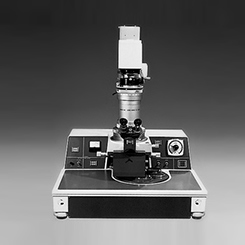History
The history of Canon's intellectual properties in the imaging field
Imaging
-
1930s-1940sCanon's origins and start in the camera business
Canon's origins can be traced back to the Precision Optical Instruments Laboratory, which was established in 1933 by a group of engineers who aspired to develop a high-end camera produced in Japan. In 1934, the company developed a prototype of Japan's first 35mm focal-plane shutter camera, named KWANON, and commercialized it in 1936 under the name Hansa Canon. The Hansa Canon had a distinctive viewfinder that popped out from the top, which was designed to not infringe a patent held by Leica Camera AG (Germany). Canon's first patent was for the mechanism of a light-shielding curtain for a camera in 1943.
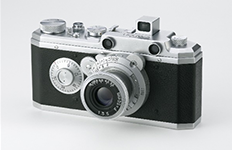
35mm focal-plane shutter rangefinder camera: Hansa Canon (launched in 1936) 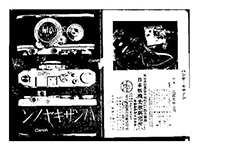
Advertisement at the time -
1950Development of original cameras
In 1951, the Canon IV was launched, which adopted a rail-directed flash synchronization system, the prototype of today's flash connection. The following year, the Canon IV Sb was launched, as the world's first camera with a built-in X-contact to synchronize with a speedlight (otherwise known as an external strobe). With these and other releases, Canon developed and patented many original camera technologies. This camera is recognized as an excellent device and a milestone in the history of Japanese cameras, with advanced functions, accuracy, and a finish that are not inferior to a Leica. Patent No. 0229067, for a flash synchronization device, received the Invention Prize at the National Commendation for Invention sponsored by the Japan Institute of Invention and Innovation in 1958.

35mm focal-plane shutter camera: IV Sb (launched in 1952) -
1960s-1970sDevelopment of cameras with new functions in quick succession
The Canonet, launched in 1961, was so inexpensive that there was a movement in the camera industry protesting against its release, and it became such an explosive success that production exceeded one million units in just two-and-a-half years. Beginning with the latest shutter speed-priority EE (Electric Eye: automatic exposure) technology incorporated in this product, Canon also continued to develop and incorporate simple film-loading technology and other functions into its products. The AE-1, launched in 1976, was the first SLR (Single-Lens Reflex) camera in the world to adopt a centralized control system using a microcomputer. Canon also developed a series of groundbreaking new products to make high-quality photography more accessible and easier, such as reducing the price by drastically reducing the number of parts, and improving shooting performance by incorporating electronic technology. These innovative technologies were protected by hundreds of patents, and contributed to Canon attaining the top share in the SLR camera market in 1978.
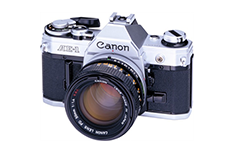
35mm focal-plane shutter SLR camera: AE-1 (launched in 1976) 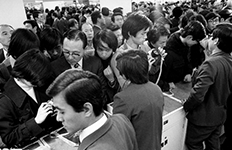
The scene at the AE-1 Announcement -
1980s-1990sBirth of EOS AF SLR cameras
In 1985, the world's first SLR camera with autofocus (AF) was launched, and became a big hit. Canon was also determined to launch an SLR camera that would outperform its competitors, and developed a number of proprietary technologies, including a distance measurement sensor capable of high-definition measurement of the distance required for AF, an electronic mount for fully electronic communication between the lens and camera, and a ring-type ultrasonic motor for fast and quiet lens movement. In 1987, Canon launched the EOS 650, incorporated with these technologies. The technology created in the development of the EOS 650 was strongly protected by a number of patents, which helped to differentiate our products and increase sales. In addition, the technology cultivated through developing a distance measurement sensor led to the development of technology for improving the image quality of CMOS (CMOS: Complementary Metal Oxide Semiconductor) sensors, which at the time were considered unsuitable for use in cameras, and the commercialization of cameras with CMOS sensors. Our patent for a distance measurement sensor (Patent No. 1950665) received the Invention Prize at the National Commendation for Invention in 1996.
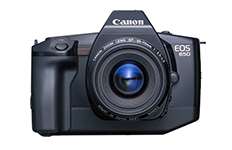
35mm focal-plane shutter SLR camera: EOS 650 (launched in 1987) -
1990Launch of a camera with an ingenious form that has been compared to a jet plane
A Canon camera (North America: PHOTURA; Europe/Asia/Oceania: EPOCA; Japan: Autoboy Jet) has been added to the permanent collection of the Museum of Modern Art (MOMA) in New York. This product, launched in 1990, with a sleek, cylindrical body like a jet, had an exterior design that caused a sensation in the age of analog cameras, where the idea of a camera being square was the norm.

35mm lens shutter camera: Autoboy Jet (launched in 1990) 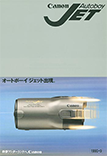
Autoboy Jet Catalog -
1990s-2000sIn-house production of digital SLR cameras and incorporation of pioneering features in products
The EOS 5 QD, launched in 1992, and the EOS 55, launched in 1995, were the world's first cameras to feature an eye-controlled focus mechanism that automatically focuses the camera according to the photographer's eye movements. This eye-controlled focus mechanism was a groundbreaking function that won many awards in Japan and abroad. Also, by intensively filing patent applications, Canon built a strong patent portfolio that prevented other companies from entering the market.
In 2000, Canon launched its first digital SLR camera, the EOS D30, incorporated with a CMOS sensor made in-house. We have acquired many patents for the technologies of using CMOS sensors in SLR cameras, which require high image quality. Patent No. 2505768 for this technology received the Invention Prize at the National Commendation for Invention in 2004, and Patent No. 3467013 received the Prize of the Chairman of Japan Business Federation at the National Commendation for Invention in 2015.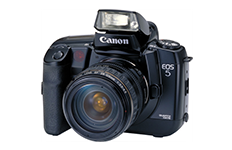
35mm focal-plane shutter SLR camera: EOS 5 QD (launched in 1992) 
CMOS sensor -
1995-2000sLaunch of the world's first lenses product line incorporated with optical shift-type image stabilization technology
In order to provide users with comfortable, high-definition photography, Canon began researching ways to compensate for camera-shake blur, a problem during shooting, in the 1980s. In 1995, we launched EF lenses incorporated with an optical shift-type image stabilization mechanism that moves the lens in the opposite direction of the shake. In support of this, we have been building a patent portfolio for this image stabilization technology since the 1990s. In 2008, Canon developed the world's first hybrid IS (IS: Image Stabilizer) for interchangeable lenses for SLR cameras, which optically corrects for two types of shake: angle camera shake caused by camera rotation, and shift camera shake caused by camera movement parallel to the image capturing surface. It was used in an interchangeable lens for macro photography launched in 2009. Inventions related to hybrid IS have been registered as patents in Japan and abroad.
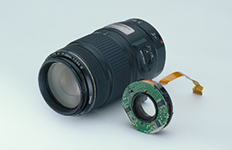
Optical shift-type image stabilization mechanism for EF lenses -
2001Launch of a digital compact camera designed to be as beautiful as an accessory you wear
The era shifted from analog cameras to digital cameras, and in 2001, Canon announced a digital compact camera (U.S. name: PowerShot S110 DIGITAL ELPH; Japanese name: IXY DIGITAL 200) that pursued beauty like an accessory you can wear around your neck. This product, which offered users the pleasure of dressing up with their camera, has also been added to the permanent collection of the Museum of Modern Art in New York. The "BOX & CIRCLE" concept is based on the basic structure of a compact camera, which has a square exterior appearance and a round shape for the lens part. The intellectual property department and the design department repeatedly discussed whether the design rights could be protected, and rights were obtained for each camera model. As a result of the development of this series, Canon received the Good Design Long Life Design Award in fiscal 2009.
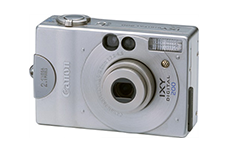
Digital still camera: IXY DIGITAL 200 (launched in 2001) -
2010 and afterFull-scale entry into the video production market
The EOS 5D Mark II, launched in 2008, was the world's first SLR camera incorporated with full HD video recording functionality, and was highly acclaimed by Hollywood and other video production professionals. In addition to the advanced optical technologies that Canon has accumulated over many years of technological development, we have started to develop cameras and lenses for video production by utilizing the digital technologies that we have cultivated for cameras. Newly developed and patented features include a full-frame 35mm CMOS sensor, capable of shooting low-noise 4K HDR video, and a mount lock system for harsh shooting environments. In 2012, Canon entered the video production market with the CINEMA EOS SYSTEM, a compact, lightweight product with a drastically reduced cost that took only about two years to produce, which was developed utilizing patents that contributed to miniaturization and cost reductions created in the development of digital cameras. Also, in 2014, for our design of a compact, lightweight digital cinema camera with excellent mobility, Canon received the Prime Minister's Prize (Design Registration No. 1439774) at the National Commendation for Invention.
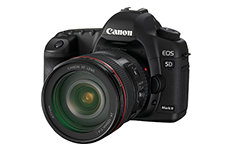
AF digital SLR camera: EOS 5D Mark II (launched in 2008) 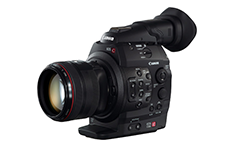
Digital cinema camera: EOS C300 (launched in 2012)
Intellectual Property History
by business field
-
Printing
The history of Canon's intellectual properties in the printing field
Read more
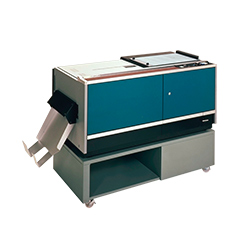
-
Medical
The history of Canon's intellectual properties in the medical field
Read more
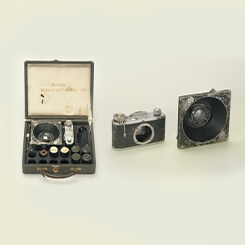
-
Imaging
The history of Canon's intellectual properties in the imaging field
Read more
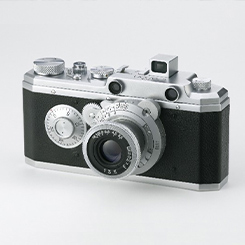
-
Industrial
The history of Canon's intellectual properties in the industrial field
Read more
